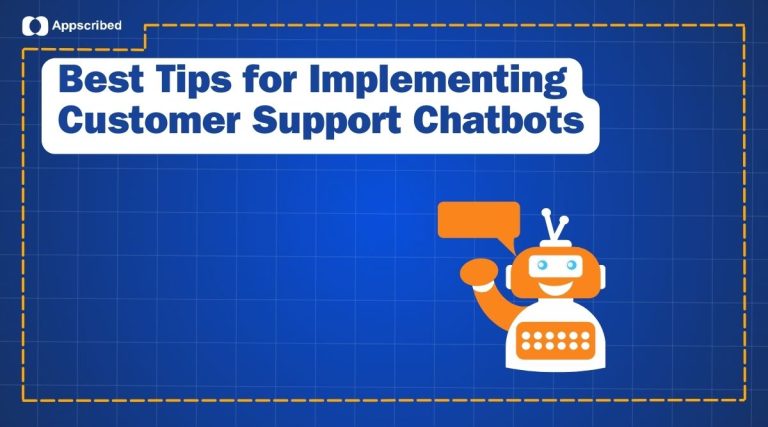Customer expectations for quick and efficient service are higher than ever. Customer support chatbots have emerged as a powerful tool to meet these expectations, providing instant assistance and streamlining support processes.
If you’re looking to implement chatbots in your customer service strategy, here are some essential tips to help you get started.
Tips to Implement Customer Support Chatbots
Define Your Customer Support Chatbot Objectives
Before you start building a chatbot, it’s crucial to define what you want to achieve. Here are some key points to consider:
- Identify Goals – What problems do you want the chatbot to solve? Whether it’s reducing response times, handling FAQs, or providing 24/7 support, clear goals will guide your chatbot design and functionality.
- Target Audience – Who will be using the chatbot? Understanding your audience helps in designing interactions that resonate with their needs and preferences.
- Key Metrics – Determine how you will measure the success of your chatbot. Common metrics include response time, resolution rate, customer satisfaction scores, and usage rates.
Ensure User-Friendly Design
A user-friendly design is critical for the success of your chatbot. Here are some tips to ensure a smooth user experience:
- Simple Language – Use clear, concise language that is easy for users to understand. Avoid jargon and complex sentences.
- Guided Prompts – Provide users with prompts and options to guide them through the interaction. This helps prevent confusion and keeps the conversation on track.
- Personalization – Personalize interactions based on user data to make the experience more engaging. For example, greet users by their name and offer solutions based on their previous interactions.
Integrate with Existing Systems
For your chatbot to be truly effective, it should seamlessly integrate with your existing customer service tools. Here’s how to achieve this:
- CRM Integration – Ensure your chatbot can access and update customer information from your CRM system. This allows for personalized interactions and efficient data management.
- Knowledge Base Integration – Connect your chatbot to your knowledge base to provide accurate and up-to-date information to users. This helps in resolving queries quickly.
- Omnichannel Support – Make sure your chatbot can operate across various channels like your website, mobile app, and social media platforms, providing a consistent support experience.
Regularly Update and Improve
To keep your chatbot effective and relevant, regular updates and improvements are essential. Here’s what you should focus on:
- Monitor Performance – Continuously track your chatbot’s performance using metrics like response time, resolution rate, and user feedback.
- Collect Feedback – Encourage users to provide feedback on their chatbot experience. Use this feedback to identify areas for improvement.
- Iterate and Improve – Based on performance data and user feedback, make necessary adjustments to your chatbot. Regular updates can include adding new functionalities, improving response accuracy, and enhancing user interactions.
Provide Human Backup
While chatbots can handle many customer queries, there will be times when human intervention is necessary. Here’s how to ensure a smooth handoff:
- Seamless Transition – Design your chatbot to recognize when an issue is beyond its capability and transfer the conversation to a human agent seamlessly.
- Human Escalation – Provide clear options for users to connect with a human agent when needed. This could be through a live chat feature, a callback option, or email support.
- Training and Support – Train your customer service team to handle escalated issues efficiently. Ensure they have access to all relevant information from the chatbot interaction to avoid asking the user to repeat themselves.
Real-Life Application Examples
To give you a clearer picture, let’s explore some real-life scenarios where customer support chatbots can be effectively implemented.
- E-commerce Support – Imagine an online store receiving hundreds of queries daily about order status, returns, and product information. A chatbot can handle these common questions instantly, freeing up human agents to focus on more complex issues. For example, the chatbot can provide real-time updates on order status, process return requests, and recommend products based on user preferences.
- Banking Services – In the banking sector, chatbots can assist customers with tasks like checking account balances, transferring funds, and answering queries about banking products. This not only improves customer satisfaction but also reduces the workload on human agents. For instance, a chatbot can guide users through the steps to reset their online banking password or provide information about loan options.
Continuous Improvement
Customer support chatbots are not a one-time setup; they require ongoing improvement to stay effective. Regularly review performance data, update the chatbot’s knowledge base, and refine its interactions based on user feedback.
For example, if you notice that users frequently ask the chatbot about a specific issue, you might need to add more detailed responses or additional resources. By continuously improving your chatbot, you ensure it remains a valuable tool for your customer support strategy.
Exploring New Technologies
The field of AI and chatbots is constantly evolving, with new technologies and capabilities emerging regularly. Stay updated with the latest advancements in LLMs to keep your chatbot ahead of the curve.
For instance, natural language processing (NLP) advancements can make your chatbot better at understanding and responding to complex queries. Voice-enabled chatbots are another area to explore, offering a more interactive and accessible support experience.
Building a Customer Support Network
Networking with other businesses and professionals in the customer support industry can provide valuable insights and opportunities for collaboration. Join industry forums, attend conferences, and participate in online discussions to learn from others’ experiences and share your own.
For example, joining a community of chatbot developers and customer support professionals on platforms like LinkedIn or attending industry-specific events can help you stay informed about best practices and new technologies.
Also Explore: Top AI Customer Support Chatbots
Conclusion
By following these tips, you can implement a customer support chatbot that enhances your service efficiency and improves customer satisfaction. Remember, the best chatbot is one that fits your business needs and evolves with your customers’ expectations.
Implementing a customer support chatbot is not about replacing human agents but about augmenting your support strategy. A well-designed chatbot can handle routine queries, provide instant assistance, and free up your human agents to focus on more complex tasks, ultimately leading to a more efficient and satisfying customer experience.












